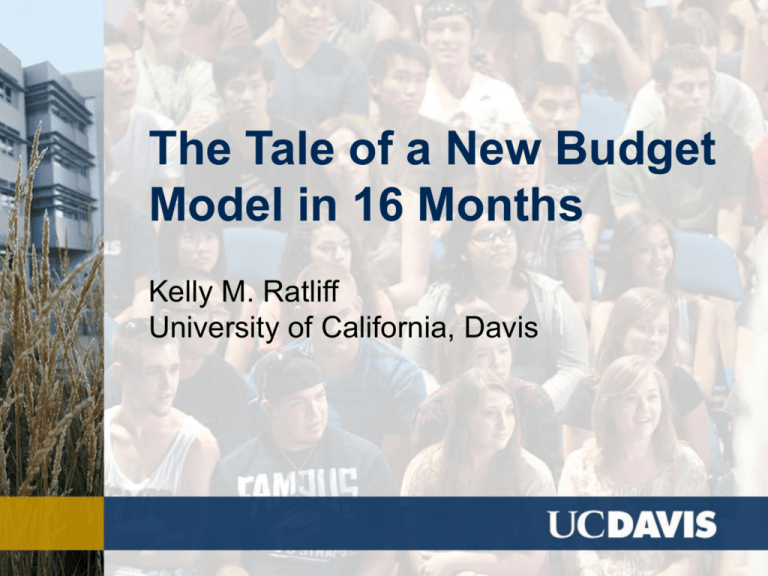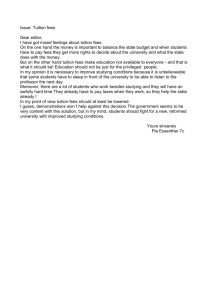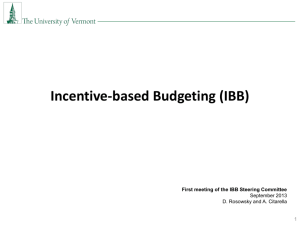Slide 1 - Budget & Institutional Analysis
advertisement

The Tale of a New Budget Model in 16 Months Kelly M. Ratliff University of California, Davis UC Davis – Campus Facts Davis Founded in 1905 Students as of fall 2012: 33,000 4 colleges, 6 professional schools 23 intercollegiate sports (NCAA Division I) 21,700 employees (4,000 faculty & 17,700 staff) 101 undergraduate majors 90 graduate programs 8th ranked public university by U.S. News & World Report Member of the Association of American Universities 1st in Sierra Magazine 2012 “Cool Schools” Survey Research funding: • 15th among U.S. ranked public universities • 22nd among public and private universities Responsibility Center Budgeting Attribute revenue to generating unit Units more responsible for funding activities Create incentives Improve student experience Identify and pursue new revenue Manage resources with eye to long-term returns Adoption Common with major private universities Relatively few public universities adopted before late 2000’s Pace by publics increased since financial crisis Primary Elements Revenue Tuition Indirect cost recovery State appropriation Support for common goods Cost allocation Role of center and units in funding in future Cultural and organizational issues State Revenue vs. Student Fees Before Funding Streams UC Office of the President Revenue Allocations Tuition & ICR 10 UC Campuses After Funding Streams UC Office of the President Expenditure Assessment Tuition & ICR 10 UC Campuses Response to Fiscal Crisis “We can either accept that permanent reductions in state support will define a new status quo for UC Davis,… or we can take control of our destiny by developing new strategies and adopting new budget models that will move the campus forward in the coming years.” Chancellor Linda P.B. Katehi July 22, 2011 Response to Fiscal Crisis Letter to the Council of Deans and Vice Chancellors “During the 2011-12 academic year, I will continue to work closely with you on the new budget process and model that we will begin implementing for the 2012-13 academic year.” Provost Ralph J. Hexter July 29, 2011 Fact-finding Trips May 2011: University of Michigan Most important takeaway: Do you want a revenue distribution model or a cost allocation model? October 2011: University of Washington Solidified our decision to focus on revenue distribution UC Davis Revenue: $3.4 billion 2012-13 Estimates Includes Medical Center UC Davis Revenue: $2.1 billion 2012-13 Estimates Excludes Medical Center Relied on Existing Stakeholder Groups No formal steering committee. To develop the model, we relied on: Regular working sessions with the Provost Council of Deans and Vice Chancellors Assistant Deans and Chief Operating Officers Academic Senate, especially the Committee for Planning and Budget Department Chairs Anyone or any group that invited us to present Enter the White Paper Key communication tool for developing the model One paper per topic Main modules: UG tuition, indirect cost recovery and provost allocation Related projects: systemwide assessment, benefits decentralization No blank slate discussions Assumed a range of practical options Starting place for discussion was version 1 Consulted and issued revised versions Used common data sources and known metrics Role of the Budget Office Data and modeling expertise resides in budget office Formulas more about gaining buy-in than actual technical work Groups can get distracted by technical dimensions Putting technical burden on budget office allows larger campus conversation Focus on new implications for management, decision-making, authority, and accountability Major Elements of New Model Phase I for 2012-13 Undergraduate tuition revenue Indirect cost recovery Provost allocation – setting the baseline and deciding future funding levels Related projects: Benefit decentralization Application of Funding Streams assessment Bridging strategies Revitalized annual budget meetings Major Elements of New Model Phase I details Undergraduate tuition revenue After return-to-aid, 70% to units & 30% to Provost Portion to units 60% student credit hours 30% degree majors 10% degrees awarded Indirect cost recovery 2012-13: 34% to units & 66% to Provost Goal of a 40%-60% split Major Elements of New Model Future phases Faculty resources Graduate tuition revenue Revisit allocation of professional tuition Self-supporting degree fees Summer session Capital and space resources Initial Model Step 1: Existing baseline budget of general funds (GF), support from central benefits pool (CBP) and indirect cost recovery (ICR) Step 2: Baseline budget recolored per new model; undergraduate tuition revenue (UGTR) and provost allocation (PA&GT) Step 3: Estimates for 2012-13 Note: Provost allocation includes graduate tuition – will disaggregate in future phase Key Success Factors Support of campus leadership and enlistment of external expertise Relied on existing committees and stakeholders Revenue distribution instead of cost allocation Use of transition and bridging strategies Previous initiatives to increase unit autonomy Use of common and easily available data sources Awareness that budget changes are as much cultural as technical Some Parts Already in Place Most institutions will already have elements in place, such as: Professional programs Self-supporting degrees Existing ICR distribution programs Rules about unused balances Pathways to a new model may not be so far These models do not remove Provost from budget allocation decisions - may refocus the process Issues and Concerns Do we understand the implications of these changes? Not everyone feels there was enough consultation Some worried about too much change, others worried that change was too incremental Unrelated concerns may get associated with the new model Dean’s office relative to departments How’d We Do? Advancing Chancellor’s Goals Conversations shifting from focus on state funds Student-centric university Activities are linked with revenue flow Having new conversations with deans They are doing the math – comparing revenue to cost Managing their portfolio of programs Budget information available sooner, better budget modeling tools Resources Budget and Institutional Analysis budget.ucdavis.edu Incentive-Based Budget Model budget.ucdavis.edu/budget-model







